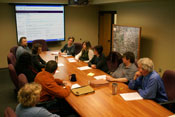Curriculum Design - Minnesota State University-Mankato
- By Mary Grush, Matt Villano
- 07/28/09
The yearly cycle of curriculum change is no longer buried in arcane paper processes at Minnesota State University-Mankato. In a collaboration between Academic Affairs and Information Technology, Brenda Flannery, assistant VP of academic affairs, and Brenda Hanel, lead web application director, led the development of a Curriculum Design System (CDS) that improves communication and transparency while tracking the workflow of curriculum change.
It’s not unusual for more than 600 curriculum proposals to be processed each year at the Mankato campus. While some curriculum changes are small, others may represent entirely new programs. Yet back in 2006, Flannery, new to her job in Academic Affairs, noticed that fewer than 4 percent of faculty fully understood the institution’s curriculum development and approval process. She also realized that the cumbersome paper-based approval process did not include any feedback loops or carry forward critical information for the design, approval, and reporting of curricular developments.
 By Fall 2008, developers on campus turned what was a complex and somewhat mysterious process into a cohesive, straightforward, web-based application, based on the Microsoft .NET platform. Faculty and staff now use the secure CDS interface to enter all proposal information electronically. The system guides users through the process, asking them questions based on the information they input, and pulls data from existing campus data sources to populate and validate fields. The CDS application then routes the proposals through a workflow involving at least six individuals or committees, and incorporates electronic signatures, comments, e-mail notifications, and RSS feeds as needed. The workflow history is available to all qualified users, and the system integrates with the university’s student records database.
By Fall 2008, developers on campus turned what was a complex and somewhat mysterious process into a cohesive, straightforward, web-based application, based on the Microsoft .NET platform. Faculty and staff now use the secure CDS interface to enter all proposal information electronically. The system guides users through the process, asking them questions based on the information they input, and pulls data from existing campus data sources to populate and validate fields. The CDS application then routes the proposals through a workflow involving at least six individuals or committees, and incorporates electronic signatures, comments, e-mail notifications, and RSS feeds as needed. The workflow history is available to all qualified users, and the system integrates with the university’s student records database.
“We are so proud of what we created because it is a democratic, user-driven innovation,” Flannery comments. “Many people sat around the table creating CDS: faculty, IT developers, staff from the Office of the Registrar, deans, curriculum committee chairpersons, people from Academic Affairs, and even administrators from our state system office. This was a collaborative process from day one.”
Faculty and administrators now enjoy the ability to create, review, track, access, and approve curricular proposals from anywhere, and can look ahead at coming curricular changes. And now that proposals no longer need to be photocopied, the university estimates 128,000 sheets of paper, plus hours of labor, will be saved this year. Flannery points out that students and advisers also benefit from unified, standard course layouts. She plans to leverage the work done on CDS as a foundation for a relational database containing hundreds of programs and thousands of courses. New applications, including a data-driven, dynamic academic bulletin, a comprehensive student advising tool, and others, will follow.
About the Authors
Mary Grush is Editor and Conference Program Director, Campus Technology.
Matt Villano is senior contributing editor of this publication.